BO1BLAW204 Business Law: Advertising & Contractual Rights Essay
VerifiedAdded on 2023/01/03
|10
|2767
|35
Essay
AI Summary
This essay analyzes a business law case involving Buster Brady's advertisement offering a reward for catching a tagged fish and the subsequent dispute with Tommy, who caught the fish unaware of the advertisement. The essay examines the elements of a valid contract, including offer, acceptance, consideration, intention, and certainty, as well as the application of unilateral contract principles. It discusses the case of Carlill v. Carbolic Smoke Ball Co. to illustrate the validity of the offer and acceptance. The essay further addresses a second scenario where Buster attempts to modify the original contract, exploring the doctrine of estoppel and its requirements, and the impact of breach of contract. The analysis includes relevant case laws such as D&C Builders v Rees and Koompahtoo Local Aboriginal Land Council v Sanpine Pty Limited, to determine the rights of both Tommy and Buster under Australian contract law. The essay concludes by determining the outcome of each scenario, focusing on the rights and obligations of each party.
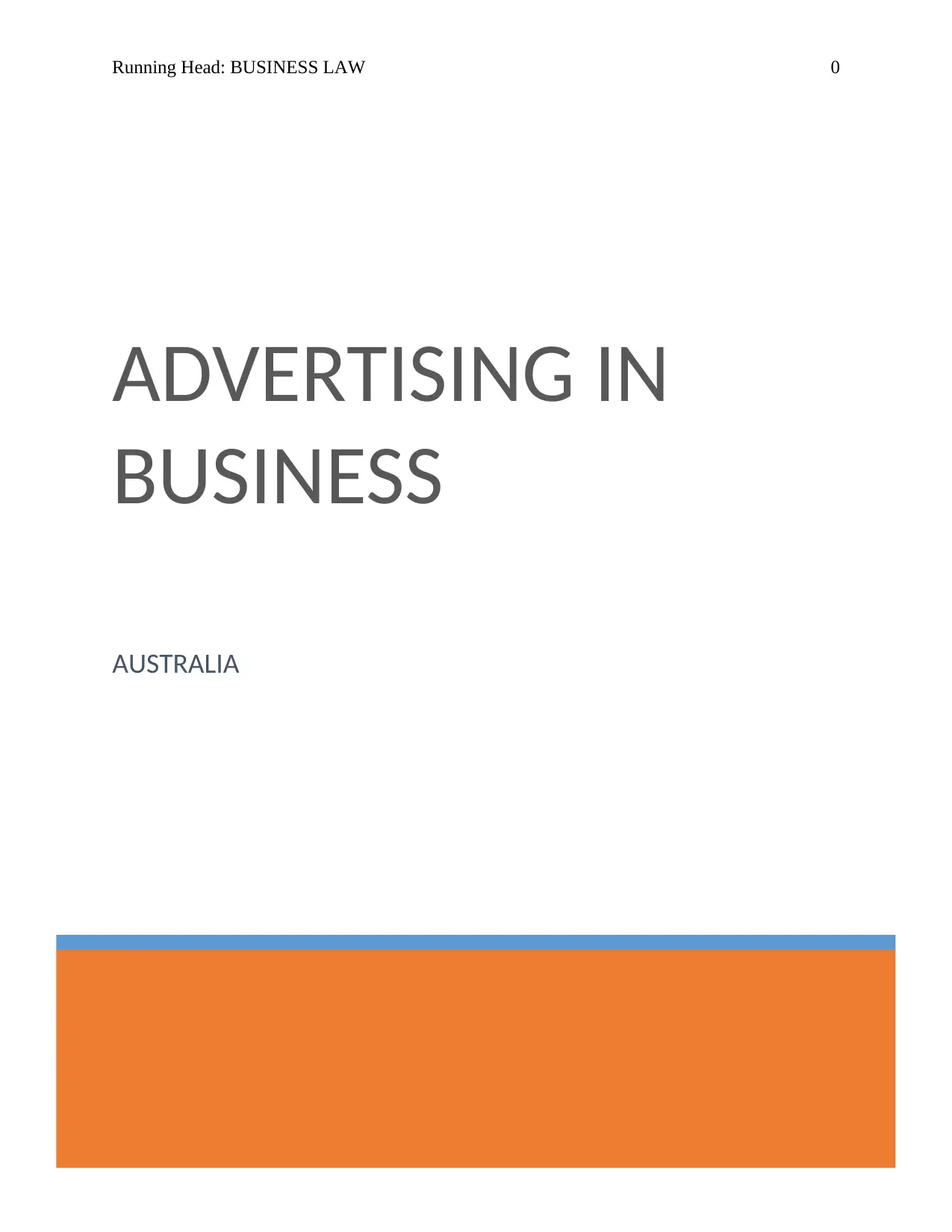
ADVERTISING IN
BUSINESS
AUSTRALIA
Running Head: BUSINESS LAW 0
BUSINESS
AUSTRALIA
Running Head: BUSINESS LAW 0
Paraphrase This Document
Need a fresh take? Get an instant paraphrase of this document with our AI Paraphraser
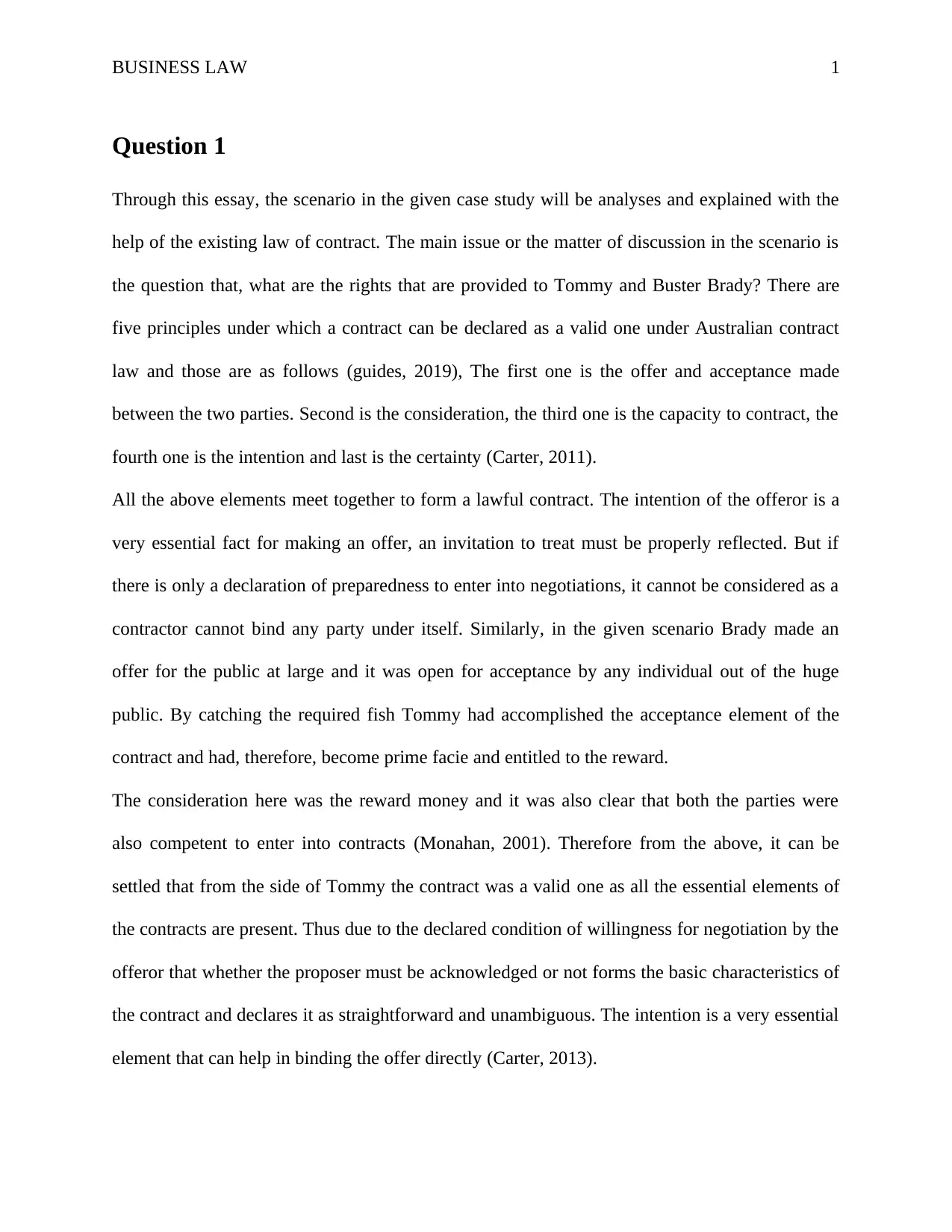
BUSINESS LAW 1
Question 1
Through this essay, the scenario in the given case study will be analyses and explained with the
help of the existing law of contract. The main issue or the matter of discussion in the scenario is
the question that, what are the rights that are provided to Tommy and Buster Brady? There are
five principles under which a contract can be declared as a valid one under Australian contract
law and those are as follows (guides, 2019), The first one is the offer and acceptance made
between the two parties. Second is the consideration, the third one is the capacity to contract, the
fourth one is the intention and last is the certainty (Carter, 2011).
All the above elements meet together to form a lawful contract. The intention of the offeror is a
very essential fact for making an offer, an invitation to treat must be properly reflected. But if
there is only a declaration of preparedness to enter into negotiations, it cannot be considered as a
contractor cannot bind any party under itself. Similarly, in the given scenario Brady made an
offer for the public at large and it was open for acceptance by any individual out of the huge
public. By catching the required fish Tommy had accomplished the acceptance element of the
contract and had, therefore, become prime facie and entitled to the reward.
The consideration here was the reward money and it was also clear that both the parties were
also competent to enter into contracts (Monahan, 2001). Therefore from the above, it can be
settled that from the side of Tommy the contract was a valid one as all the essential elements of
the contracts are present. Thus due to the declared condition of willingness for negotiation by the
offeror that whether the proposer must be acknowledged or not forms the basic characteristics of
the contract and declares it as straightforward and unambiguous. The intention is a very essential
element that can help in binding the offer directly (Carter, 2013).
Question 1
Through this essay, the scenario in the given case study will be analyses and explained with the
help of the existing law of contract. The main issue or the matter of discussion in the scenario is
the question that, what are the rights that are provided to Tommy and Buster Brady? There are
five principles under which a contract can be declared as a valid one under Australian contract
law and those are as follows (guides, 2019), The first one is the offer and acceptance made
between the two parties. Second is the consideration, the third one is the capacity to contract, the
fourth one is the intention and last is the certainty (Carter, 2011).
All the above elements meet together to form a lawful contract. The intention of the offeror is a
very essential fact for making an offer, an invitation to treat must be properly reflected. But if
there is only a declaration of preparedness to enter into negotiations, it cannot be considered as a
contractor cannot bind any party under itself. Similarly, in the given scenario Brady made an
offer for the public at large and it was open for acceptance by any individual out of the huge
public. By catching the required fish Tommy had accomplished the acceptance element of the
contract and had, therefore, become prime facie and entitled to the reward.
The consideration here was the reward money and it was also clear that both the parties were
also competent to enter into contracts (Monahan, 2001). Therefore from the above, it can be
settled that from the side of Tommy the contract was a valid one as all the essential elements of
the contracts are present. Thus due to the declared condition of willingness for negotiation by the
offeror that whether the proposer must be acknowledged or not forms the basic characteristics of
the contract and declares it as straightforward and unambiguous. The intention is a very essential
element that can help in binding the offer directly (Carter, 2013).
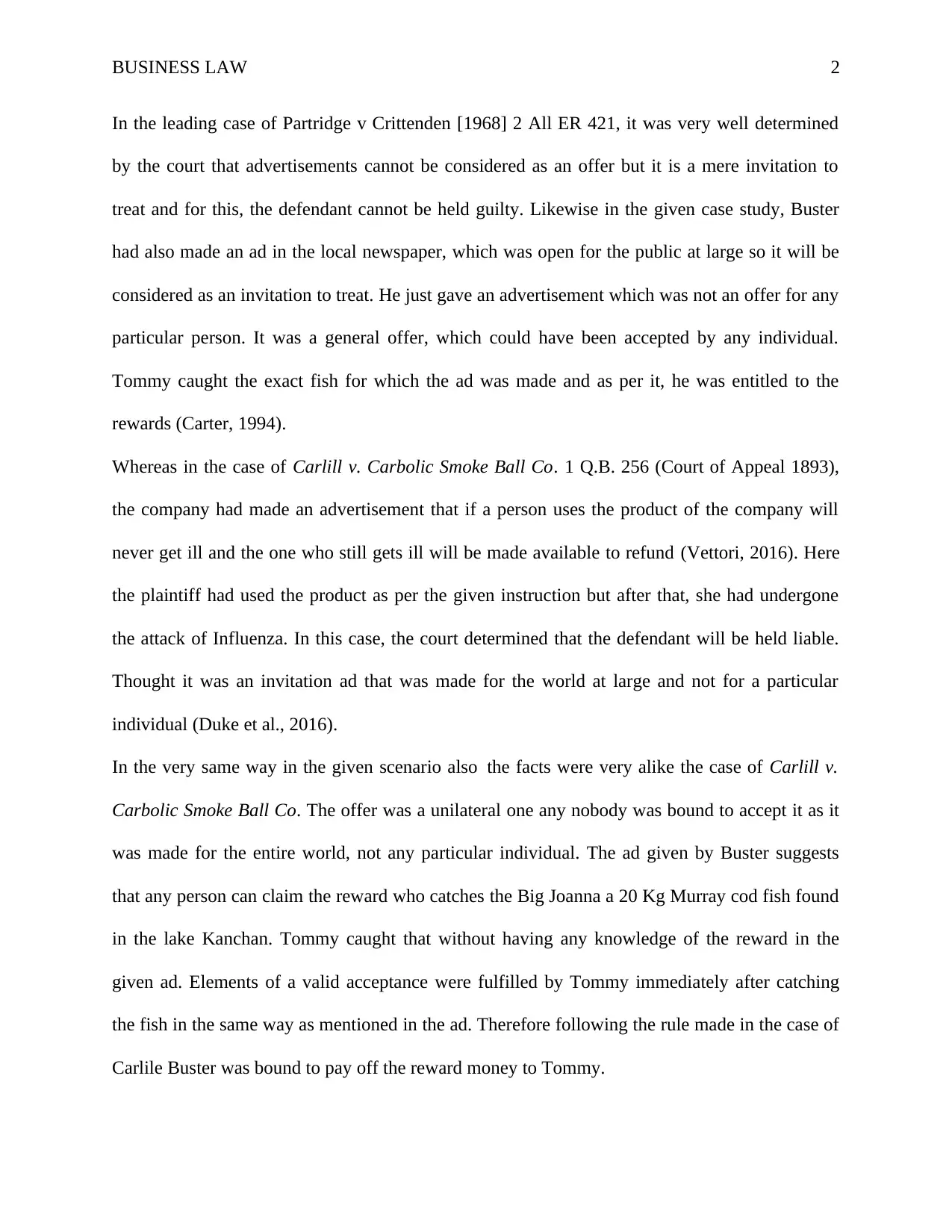
BUSINESS LAW 2
In the leading case of Partridge v Crittenden [1968] 2 All ER 421, it was very well determined
by the court that advertisements cannot be considered as an offer but it is a mere invitation to
treat and for this, the defendant cannot be held guilty. Likewise in the given case study, Buster
had also made an ad in the local newspaper, which was open for the public at large so it will be
considered as an invitation to treat. He just gave an advertisement which was not an offer for any
particular person. It was a general offer, which could have been accepted by any individual.
Tommy caught the exact fish for which the ad was made and as per it, he was entitled to the
rewards (Carter, 1994).
Whereas in the case of Carlill v. Carbolic Smoke Ball Co. 1 Q.B. 256 (Court of Appeal 1893),
the company had made an advertisement that if a person uses the product of the company will
never get ill and the one who still gets ill will be made available to refund (Vettori, 2016). Here
the plaintiff had used the product as per the given instruction but after that, she had undergone
the attack of Influenza. In this case, the court determined that the defendant will be held liable.
Thought it was an invitation ad that was made for the world at large and not for a particular
individual (Duke et al., 2016).
In the very same way in the given scenario also the facts were very alike the case of Carlill v.
Carbolic Smoke Ball Co. The offer was a unilateral one any nobody was bound to accept it as it
was made for the entire world, not any particular individual. The ad given by Buster suggests
that any person can claim the reward who catches the Big Joanna a 20 Kg Murray cod fish found
in the lake Kanchan. Tommy caught that without having any knowledge of the reward in the
given ad. Elements of a valid acceptance were fulfilled by Tommy immediately after catching
the fish in the same way as mentioned in the ad. Therefore following the rule made in the case of
Carlile Buster was bound to pay off the reward money to Tommy.
In the leading case of Partridge v Crittenden [1968] 2 All ER 421, it was very well determined
by the court that advertisements cannot be considered as an offer but it is a mere invitation to
treat and for this, the defendant cannot be held guilty. Likewise in the given case study, Buster
had also made an ad in the local newspaper, which was open for the public at large so it will be
considered as an invitation to treat. He just gave an advertisement which was not an offer for any
particular person. It was a general offer, which could have been accepted by any individual.
Tommy caught the exact fish for which the ad was made and as per it, he was entitled to the
rewards (Carter, 1994).
Whereas in the case of Carlill v. Carbolic Smoke Ball Co. 1 Q.B. 256 (Court of Appeal 1893),
the company had made an advertisement that if a person uses the product of the company will
never get ill and the one who still gets ill will be made available to refund (Vettori, 2016). Here
the plaintiff had used the product as per the given instruction but after that, she had undergone
the attack of Influenza. In this case, the court determined that the defendant will be held liable.
Thought it was an invitation ad that was made for the world at large and not for a particular
individual (Duke et al., 2016).
In the very same way in the given scenario also the facts were very alike the case of Carlill v.
Carbolic Smoke Ball Co. The offer was a unilateral one any nobody was bound to accept it as it
was made for the entire world, not any particular individual. The ad given by Buster suggests
that any person can claim the reward who catches the Big Joanna a 20 Kg Murray cod fish found
in the lake Kanchan. Tommy caught that without having any knowledge of the reward in the
given ad. Elements of a valid acceptance were fulfilled by Tommy immediately after catching
the fish in the same way as mentioned in the ad. Therefore following the rule made in the case of
Carlile Buster was bound to pay off the reward money to Tommy.
⊘ This is a preview!⊘
Do you want full access?
Subscribe today to unlock all pages.

Trusted by 1+ million students worldwide
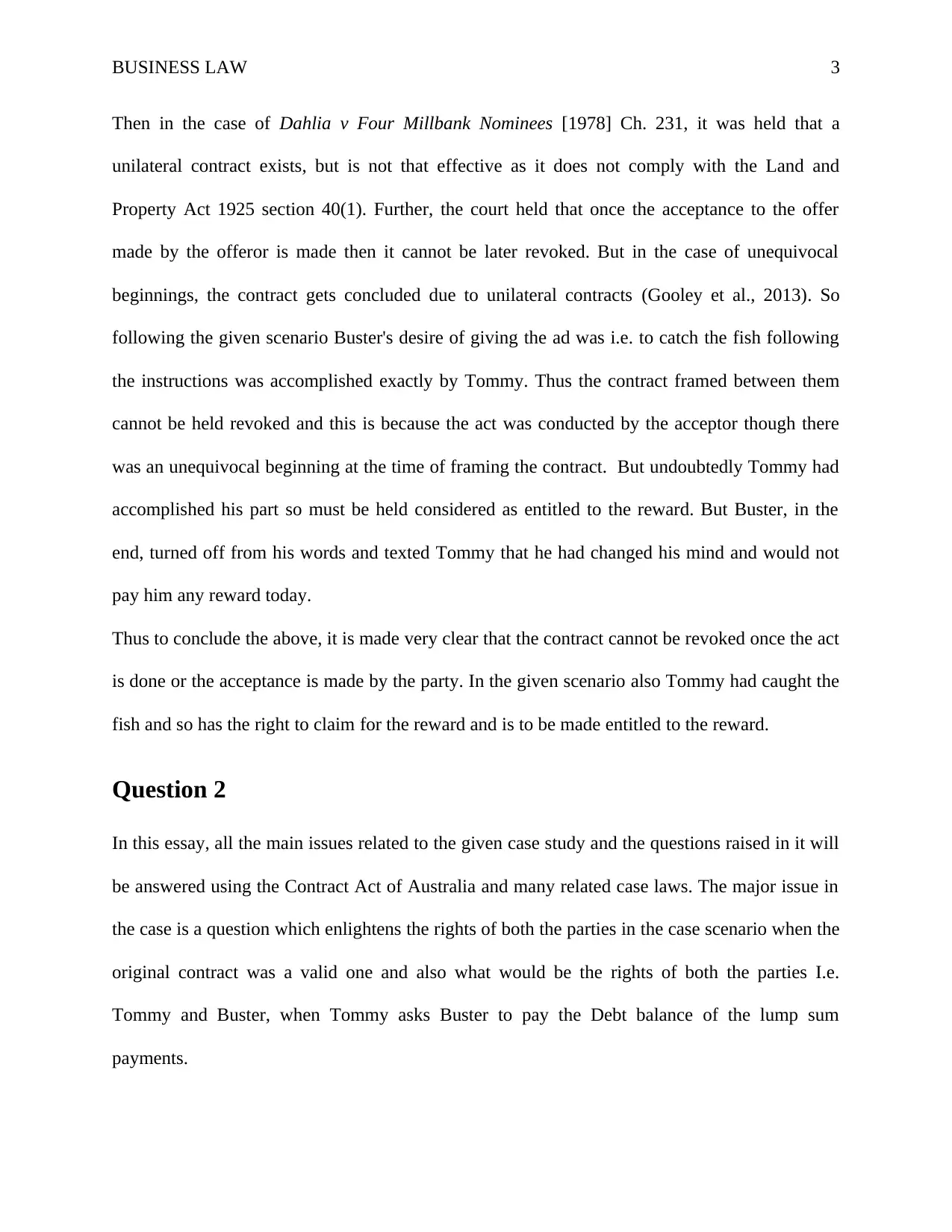
BUSINESS LAW 3
Then in the case of Dahlia v Four Millbank Nominees [1978] Ch. 231, it was held that a
unilateral contract exists, but is not that effective as it does not comply with the Land and
Property Act 1925 section 40(1). Further, the court held that once the acceptance to the offer
made by the offeror is made then it cannot be later revoked. But in the case of unequivocal
beginnings, the contract gets concluded due to unilateral contracts (Gooley et al., 2013). So
following the given scenario Buster's desire of giving the ad was i.e. to catch the fish following
the instructions was accomplished exactly by Tommy. Thus the contract framed between them
cannot be held revoked and this is because the act was conducted by the acceptor though there
was an unequivocal beginning at the time of framing the contract. But undoubtedly Tommy had
accomplished his part so must be held considered as entitled to the reward. But Buster, in the
end, turned off from his words and texted Tommy that he had changed his mind and would not
pay him any reward today.
Thus to conclude the above, it is made very clear that the contract cannot be revoked once the act
is done or the acceptance is made by the party. In the given scenario also Tommy had caught the
fish and so has the right to claim for the reward and is to be made entitled to the reward.
Question 2
In this essay, all the main issues related to the given case study and the questions raised in it will
be answered using the Contract Act of Australia and many related case laws. The major issue in
the case is a question which enlightens the rights of both the parties in the case scenario when the
original contract was a valid one and also what would be the rights of both the parties I.e.
Tommy and Buster, when Tommy asks Buster to pay the Debt balance of the lump sum
payments.
Then in the case of Dahlia v Four Millbank Nominees [1978] Ch. 231, it was held that a
unilateral contract exists, but is not that effective as it does not comply with the Land and
Property Act 1925 section 40(1). Further, the court held that once the acceptance to the offer
made by the offeror is made then it cannot be later revoked. But in the case of unequivocal
beginnings, the contract gets concluded due to unilateral contracts (Gooley et al., 2013). So
following the given scenario Buster's desire of giving the ad was i.e. to catch the fish following
the instructions was accomplished exactly by Tommy. Thus the contract framed between them
cannot be held revoked and this is because the act was conducted by the acceptor though there
was an unequivocal beginning at the time of framing the contract. But undoubtedly Tommy had
accomplished his part so must be held considered as entitled to the reward. But Buster, in the
end, turned off from his words and texted Tommy that he had changed his mind and would not
pay him any reward today.
Thus to conclude the above, it is made very clear that the contract cannot be revoked once the act
is done or the acceptance is made by the party. In the given scenario also Tommy had caught the
fish and so has the right to claim for the reward and is to be made entitled to the reward.
Question 2
In this essay, all the main issues related to the given case study and the questions raised in it will
be answered using the Contract Act of Australia and many related case laws. The major issue in
the case is a question which enlightens the rights of both the parties in the case scenario when the
original contract was a valid one and also what would be the rights of both the parties I.e.
Tommy and Buster, when Tommy asks Buster to pay the Debt balance of the lump sum
payments.
Paraphrase This Document
Need a fresh take? Get an instant paraphrase of this document with our AI Paraphraser
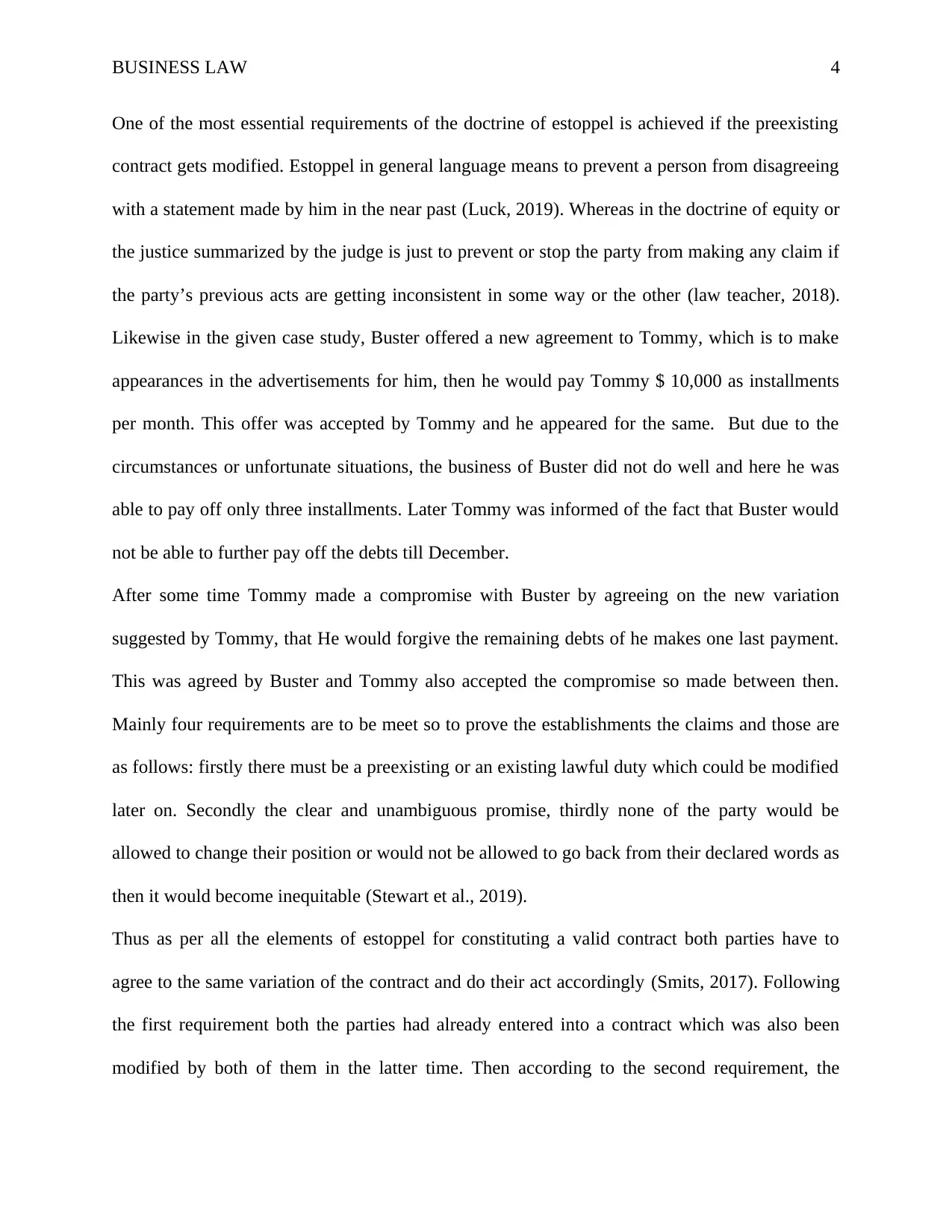
BUSINESS LAW 4
One of the most essential requirements of the doctrine of estoppel is achieved if the preexisting
contract gets modified. Estoppel in general language means to prevent a person from disagreeing
with a statement made by him in the near past (Luck, 2019). Whereas in the doctrine of equity or
the justice summarized by the judge is just to prevent or stop the party from making any claim if
the party’s previous acts are getting inconsistent in some way or the other (law teacher, 2018).
Likewise in the given case study, Buster offered a new agreement to Tommy, which is to make
appearances in the advertisements for him, then he would pay Tommy $ 10,000 as installments
per month. This offer was accepted by Tommy and he appeared for the same. But due to the
circumstances or unfortunate situations, the business of Buster did not do well and here he was
able to pay off only three installments. Later Tommy was informed of the fact that Buster would
not be able to further pay off the debts till December.
After some time Tommy made a compromise with Buster by agreeing on the new variation
suggested by Tommy, that He would forgive the remaining debts of he makes one last payment.
This was agreed by Buster and Tommy also accepted the compromise so made between then.
Mainly four requirements are to be meet so to prove the establishments the claims and those are
as follows: firstly there must be a preexisting or an existing lawful duty which could be modified
later on. Secondly the clear and unambiguous promise, thirdly none of the party would be
allowed to change their position or would not be allowed to go back from their declared words as
then it would become inequitable (Stewart et al., 2019).
Thus as per all the elements of estoppel for constituting a valid contract both parties have to
agree to the same variation of the contract and do their act accordingly (Smits, 2017). Following
the first requirement both the parties had already entered into a contract which was also been
modified by both of them in the latter time. Then according to the second requirement, the
One of the most essential requirements of the doctrine of estoppel is achieved if the preexisting
contract gets modified. Estoppel in general language means to prevent a person from disagreeing
with a statement made by him in the near past (Luck, 2019). Whereas in the doctrine of equity or
the justice summarized by the judge is just to prevent or stop the party from making any claim if
the party’s previous acts are getting inconsistent in some way or the other (law teacher, 2018).
Likewise in the given case study, Buster offered a new agreement to Tommy, which is to make
appearances in the advertisements for him, then he would pay Tommy $ 10,000 as installments
per month. This offer was accepted by Tommy and he appeared for the same. But due to the
circumstances or unfortunate situations, the business of Buster did not do well and here he was
able to pay off only three installments. Later Tommy was informed of the fact that Buster would
not be able to further pay off the debts till December.
After some time Tommy made a compromise with Buster by agreeing on the new variation
suggested by Tommy, that He would forgive the remaining debts of he makes one last payment.
This was agreed by Buster and Tommy also accepted the compromise so made between then.
Mainly four requirements are to be meet so to prove the establishments the claims and those are
as follows: firstly there must be a preexisting or an existing lawful duty which could be modified
later on. Secondly the clear and unambiguous promise, thirdly none of the party would be
allowed to change their position or would not be allowed to go back from their declared words as
then it would become inequitable (Stewart et al., 2019).
Thus as per all the elements of estoppel for constituting a valid contract both parties have to
agree to the same variation of the contract and do their act accordingly (Smits, 2017). Following
the first requirement both the parties had already entered into a contract which was also been
modified by both of them in the latter time. Then according to the second requirement, the
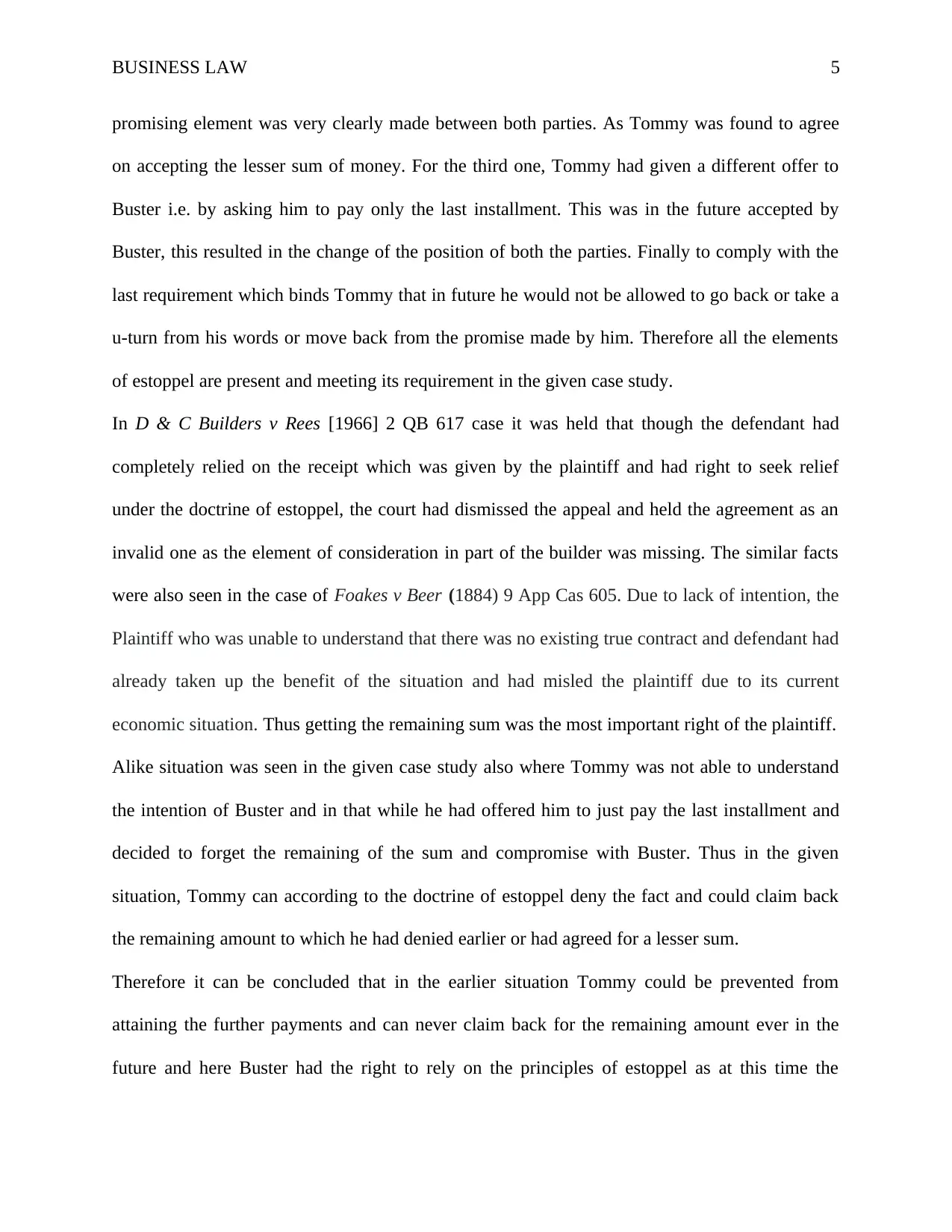
BUSINESS LAW 5
promising element was very clearly made between both parties. As Tommy was found to agree
on accepting the lesser sum of money. For the third one, Tommy had given a different offer to
Buster i.e. by asking him to pay only the last installment. This was in the future accepted by
Buster, this resulted in the change of the position of both the parties. Finally to comply with the
last requirement which binds Tommy that in future he would not be allowed to go back or take a
u-turn from his words or move back from the promise made by him. Therefore all the elements
of estoppel are present and meeting its requirement in the given case study.
In D & C Builders v Rees [1966] 2 QB 617 case it was held that though the defendant had
completely relied on the receipt which was given by the plaintiff and had right to seek relief
under the doctrine of estoppel, the court had dismissed the appeal and held the agreement as an
invalid one as the element of consideration in part of the builder was missing. The similar facts
were also seen in the case of Foakes v Beer (1884) 9 App Cas 605. Due to lack of intention, the
Plaintiff who was unable to understand that there was no existing true contract and defendant had
already taken up the benefit of the situation and had misled the plaintiff due to its current
economic situation. Thus getting the remaining sum was the most important right of the plaintiff.
Alike situation was seen in the given case study also where Tommy was not able to understand
the intention of Buster and in that while he had offered him to just pay the last installment and
decided to forget the remaining of the sum and compromise with Buster. Thus in the given
situation, Tommy can according to the doctrine of estoppel deny the fact and could claim back
the remaining amount to which he had denied earlier or had agreed for a lesser sum.
Therefore it can be concluded that in the earlier situation Tommy could be prevented from
attaining the further payments and can never claim back for the remaining amount ever in the
future and here Buster had the right to rely on the principles of estoppel as at this time the
promising element was very clearly made between both parties. As Tommy was found to agree
on accepting the lesser sum of money. For the third one, Tommy had given a different offer to
Buster i.e. by asking him to pay only the last installment. This was in the future accepted by
Buster, this resulted in the change of the position of both the parties. Finally to comply with the
last requirement which binds Tommy that in future he would not be allowed to go back or take a
u-turn from his words or move back from the promise made by him. Therefore all the elements
of estoppel are present and meeting its requirement in the given case study.
In D & C Builders v Rees [1966] 2 QB 617 case it was held that though the defendant had
completely relied on the receipt which was given by the plaintiff and had right to seek relief
under the doctrine of estoppel, the court had dismissed the appeal and held the agreement as an
invalid one as the element of consideration in part of the builder was missing. The similar facts
were also seen in the case of Foakes v Beer (1884) 9 App Cas 605. Due to lack of intention, the
Plaintiff who was unable to understand that there was no existing true contract and defendant had
already taken up the benefit of the situation and had misled the plaintiff due to its current
economic situation. Thus getting the remaining sum was the most important right of the plaintiff.
Alike situation was seen in the given case study also where Tommy was not able to understand
the intention of Buster and in that while he had offered him to just pay the last installment and
decided to forget the remaining of the sum and compromise with Buster. Thus in the given
situation, Tommy can according to the doctrine of estoppel deny the fact and could claim back
the remaining amount to which he had denied earlier or had agreed for a lesser sum.
Therefore it can be concluded that in the earlier situation Tommy could be prevented from
attaining the further payments and can never claim back for the remaining amount ever in the
future and here Buster had the right to rely on the principles of estoppel as at this time the
⊘ This is a preview!⊘
Do you want full access?
Subscribe today to unlock all pages.

Trusted by 1+ million students worldwide
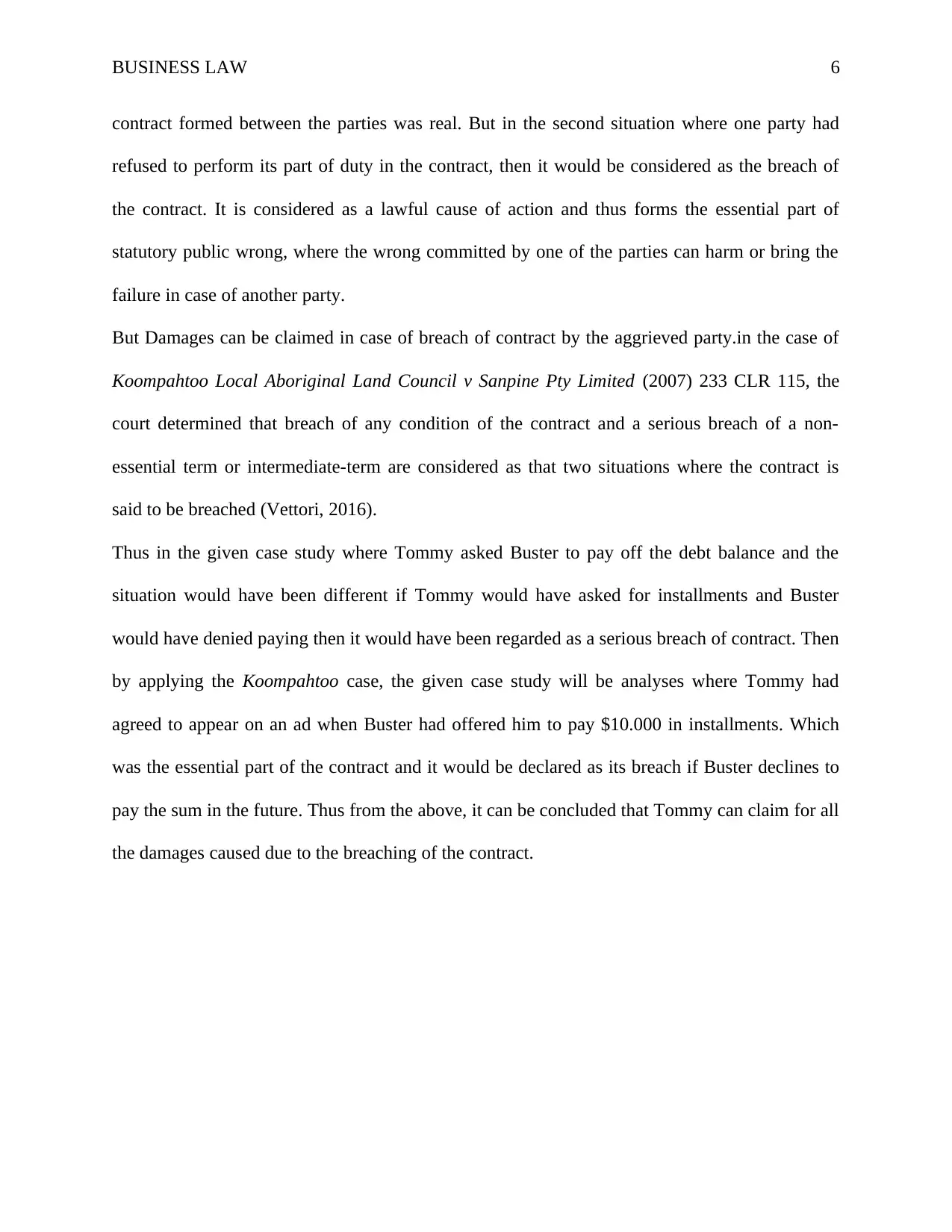
BUSINESS LAW 6
contract formed between the parties was real. But in the second situation where one party had
refused to perform its part of duty in the contract, then it would be considered as the breach of
the contract. It is considered as a lawful cause of action and thus forms the essential part of
statutory public wrong, where the wrong committed by one of the parties can harm or bring the
failure in case of another party.
But Damages can be claimed in case of breach of contract by the aggrieved party.in the case of
Koompahtoo Local Aboriginal Land Council v Sanpine Pty Limited (2007) 233 CLR 115, the
court determined that breach of any condition of the contract and a serious breach of a non-
essential term or intermediate-term are considered as that two situations where the contract is
said to be breached (Vettori, 2016).
Thus in the given case study where Tommy asked Buster to pay off the debt balance and the
situation would have been different if Tommy would have asked for installments and Buster
would have denied paying then it would have been regarded as a serious breach of contract. Then
by applying the Koompahtoo case, the given case study will be analyses where Tommy had
agreed to appear on an ad when Buster had offered him to pay $10.000 in installments. Which
was the essential part of the contract and it would be declared as its breach if Buster declines to
pay the sum in the future. Thus from the above, it can be concluded that Tommy can claim for all
the damages caused due to the breaching of the contract.
contract formed between the parties was real. But in the second situation where one party had
refused to perform its part of duty in the contract, then it would be considered as the breach of
the contract. It is considered as a lawful cause of action and thus forms the essential part of
statutory public wrong, where the wrong committed by one of the parties can harm or bring the
failure in case of another party.
But Damages can be claimed in case of breach of contract by the aggrieved party.in the case of
Koompahtoo Local Aboriginal Land Council v Sanpine Pty Limited (2007) 233 CLR 115, the
court determined that breach of any condition of the contract and a serious breach of a non-
essential term or intermediate-term are considered as that two situations where the contract is
said to be breached (Vettori, 2016).
Thus in the given case study where Tommy asked Buster to pay off the debt balance and the
situation would have been different if Tommy would have asked for installments and Buster
would have denied paying then it would have been regarded as a serious breach of contract. Then
by applying the Koompahtoo case, the given case study will be analyses where Tommy had
agreed to appear on an ad when Buster had offered him to pay $10.000 in installments. Which
was the essential part of the contract and it would be declared as its breach if Buster declines to
pay the sum in the future. Thus from the above, it can be concluded that Tommy can claim for all
the damages caused due to the breaching of the contract.
Paraphrase This Document
Need a fresh take? Get an instant paraphrase of this document with our AI Paraphraser
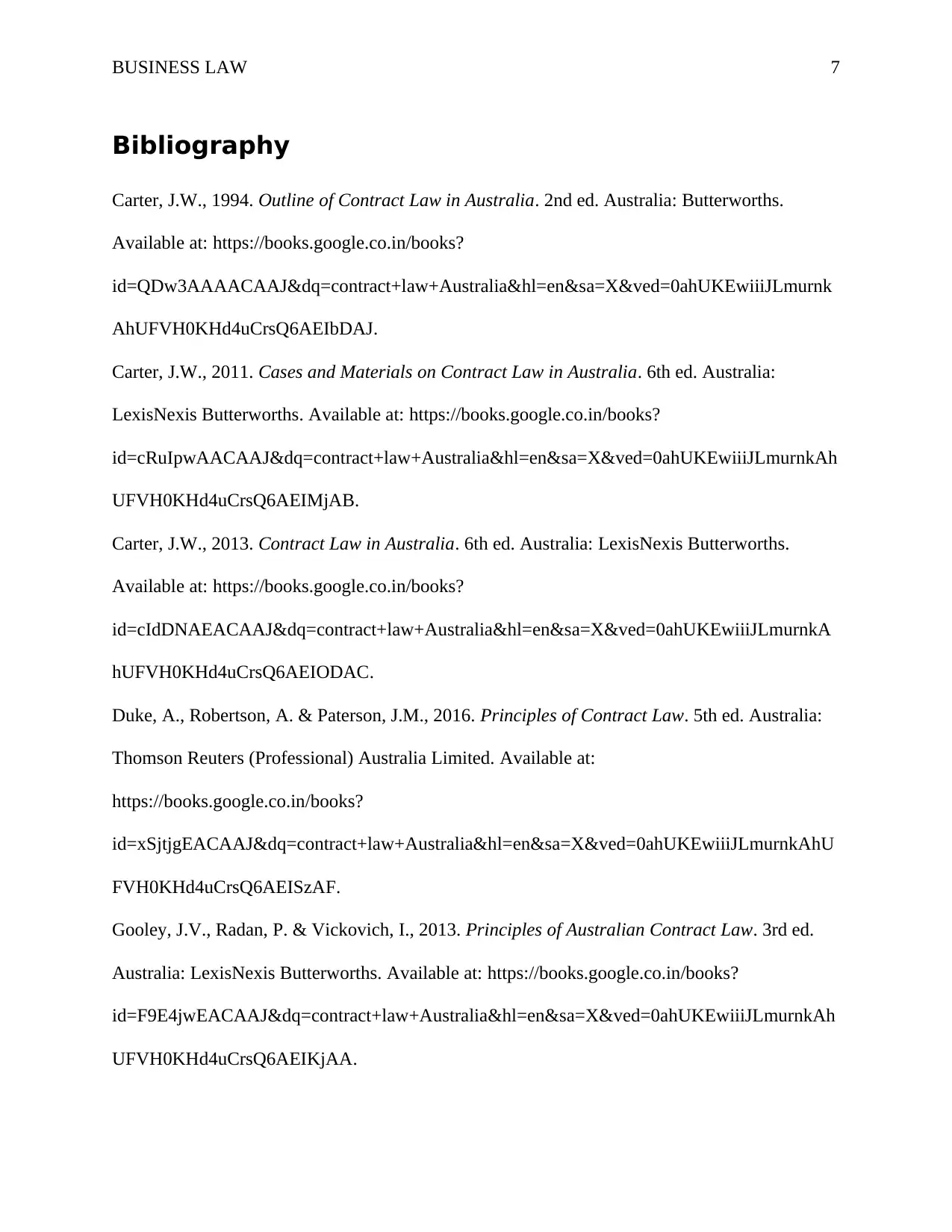
BUSINESS LAW 7
Bibliography
Carter, J.W., 1994. Outline of Contract Law in Australia. 2nd ed. Australia: Butterworths.
Available at: https://books.google.co.in/books?
id=QDw3AAAACAAJ&dq=contract+law+Australia&hl=en&sa=X&ved=0ahUKEwiiiJLmurnk
AhUFVH0KHd4uCrsQ6AEIbDAJ.
Carter, J.W., 2011. Cases and Materials on Contract Law in Australia. 6th ed. Australia:
LexisNexis Butterworths. Available at: https://books.google.co.in/books?
id=cRuIpwAACAAJ&dq=contract+law+Australia&hl=en&sa=X&ved=0ahUKEwiiiJLmurnkAh
UFVH0KHd4uCrsQ6AEIMjAB.
Carter, J.W., 2013. Contract Law in Australia. 6th ed. Australia: LexisNexis Butterworths.
Available at: https://books.google.co.in/books?
id=cIdDNAEACAAJ&dq=contract+law+Australia&hl=en&sa=X&ved=0ahUKEwiiiJLmurnkA
hUFVH0KHd4uCrsQ6AEIODAC.
Duke, A., Robertson, A. & Paterson, J.M., 2016. Principles of Contract Law. 5th ed. Australia:
Thomson Reuters (Professional) Australia Limited. Available at:
https://books.google.co.in/books?
id=xSjtjgEACAAJ&dq=contract+law+Australia&hl=en&sa=X&ved=0ahUKEwiiiJLmurnkAhU
FVH0KHd4uCrsQ6AEISzAF.
Gooley, J.V., Radan, P. & Vickovich, I., 2013. Principles of Australian Contract Law. 3rd ed.
Australia: LexisNexis Butterworths. Available at: https://books.google.co.in/books?
id=F9E4jwEACAAJ&dq=contract+law+Australia&hl=en&sa=X&ved=0ahUKEwiiiJLmurnkAh
UFVH0KHd4uCrsQ6AEIKjAA.
Bibliography
Carter, J.W., 1994. Outline of Contract Law in Australia. 2nd ed. Australia: Butterworths.
Available at: https://books.google.co.in/books?
id=QDw3AAAACAAJ&dq=contract+law+Australia&hl=en&sa=X&ved=0ahUKEwiiiJLmurnk
AhUFVH0KHd4uCrsQ6AEIbDAJ.
Carter, J.W., 2011. Cases and Materials on Contract Law in Australia. 6th ed. Australia:
LexisNexis Butterworths. Available at: https://books.google.co.in/books?
id=cRuIpwAACAAJ&dq=contract+law+Australia&hl=en&sa=X&ved=0ahUKEwiiiJLmurnkAh
UFVH0KHd4uCrsQ6AEIMjAB.
Carter, J.W., 2013. Contract Law in Australia. 6th ed. Australia: LexisNexis Butterworths.
Available at: https://books.google.co.in/books?
id=cIdDNAEACAAJ&dq=contract+law+Australia&hl=en&sa=X&ved=0ahUKEwiiiJLmurnkA
hUFVH0KHd4uCrsQ6AEIODAC.
Duke, A., Robertson, A. & Paterson, J.M., 2016. Principles of Contract Law. 5th ed. Australia:
Thomson Reuters (Professional) Australia Limited. Available at:
https://books.google.co.in/books?
id=xSjtjgEACAAJ&dq=contract+law+Australia&hl=en&sa=X&ved=0ahUKEwiiiJLmurnkAhU
FVH0KHd4uCrsQ6AEISzAF.
Gooley, J.V., Radan, P. & Vickovich, I., 2013. Principles of Australian Contract Law. 3rd ed.
Australia: LexisNexis Butterworths. Available at: https://books.google.co.in/books?
id=F9E4jwEACAAJ&dq=contract+law+Australia&hl=en&sa=X&ved=0ahUKEwiiiJLmurnkAh
UFVH0KHd4uCrsQ6AEIKjAA.
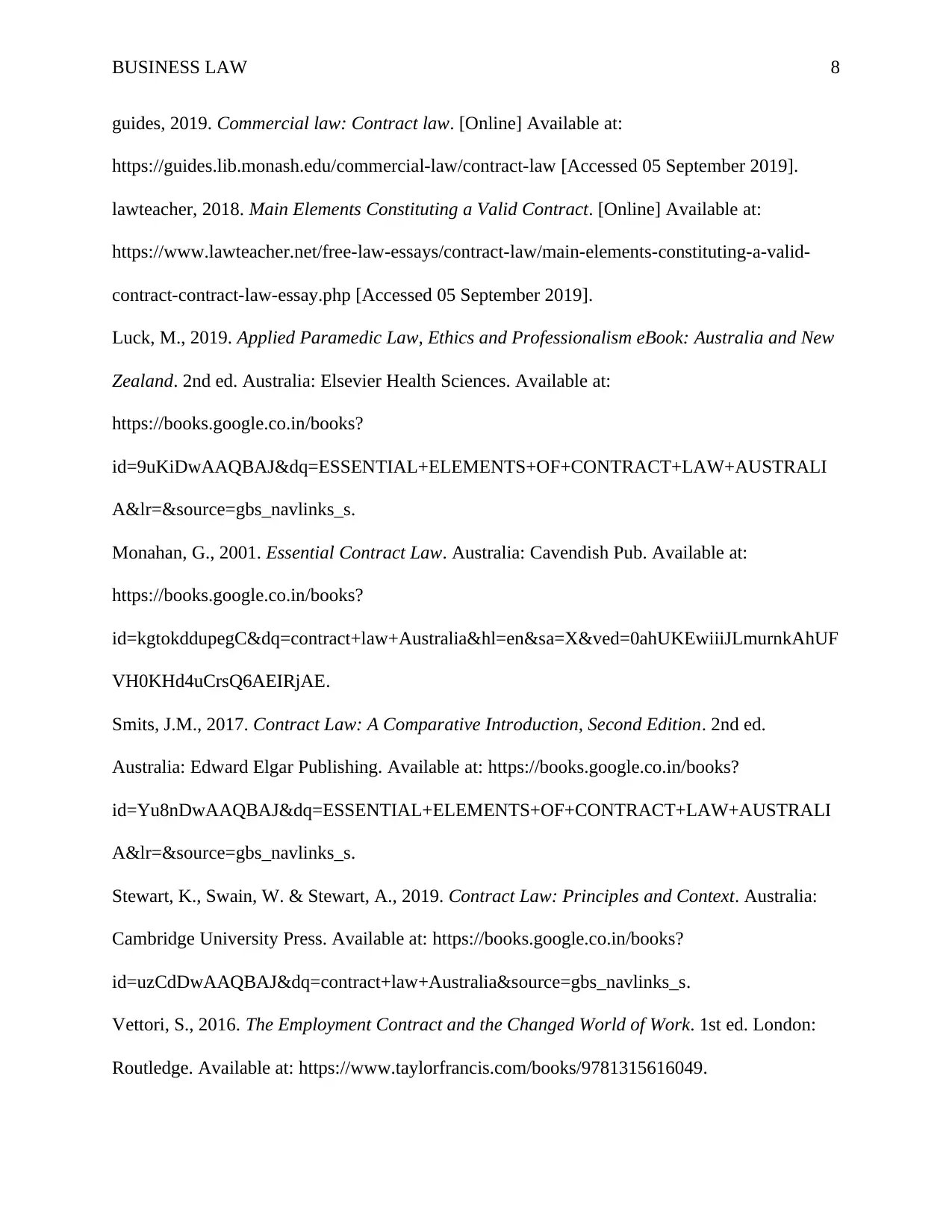
BUSINESS LAW 8
guides, 2019. Commercial law: Contract law. [Online] Available at:
https://guides.lib.monash.edu/commercial-law/contract-law [Accessed 05 September 2019].
lawteacher, 2018. Main Elements Constituting a Valid Contract. [Online] Available at:
https://www.lawteacher.net/free-law-essays/contract-law/main-elements-constituting-a-valid-
contract-contract-law-essay.php [Accessed 05 September 2019].
Luck, M., 2019. Applied Paramedic Law, Ethics and Professionalism eBook: Australia and New
Zealand. 2nd ed. Australia: Elsevier Health Sciences. Available at:
https://books.google.co.in/books?
id=9uKiDwAAQBAJ&dq=ESSENTIAL+ELEMENTS+OF+CONTRACT+LAW+AUSTRALI
A&lr=&source=gbs_navlinks_s.
Monahan, G., 2001. Essential Contract Law. Australia: Cavendish Pub. Available at:
https://books.google.co.in/books?
id=kgtokddupegC&dq=contract+law+Australia&hl=en&sa=X&ved=0ahUKEwiiiJLmurnkAhUF
VH0KHd4uCrsQ6AEIRjAE.
Smits, J.M., 2017. Contract Law: A Comparative Introduction, Second Edition. 2nd ed.
Australia: Edward Elgar Publishing. Available at: https://books.google.co.in/books?
id=Yu8nDwAAQBAJ&dq=ESSENTIAL+ELEMENTS+OF+CONTRACT+LAW+AUSTRALI
A&lr=&source=gbs_navlinks_s.
Stewart, K., Swain, W. & Stewart, A., 2019. Contract Law: Principles and Context. Australia:
Cambridge University Press. Available at: https://books.google.co.in/books?
id=uzCdDwAAQBAJ&dq=contract+law+Australia&source=gbs_navlinks_s.
Vettori, S., 2016. The Employment Contract and the Changed World of Work. 1st ed. London:
Routledge. Available at: https://www.taylorfrancis.com/books/9781315616049.
guides, 2019. Commercial law: Contract law. [Online] Available at:
https://guides.lib.monash.edu/commercial-law/contract-law [Accessed 05 September 2019].
lawteacher, 2018. Main Elements Constituting a Valid Contract. [Online] Available at:
https://www.lawteacher.net/free-law-essays/contract-law/main-elements-constituting-a-valid-
contract-contract-law-essay.php [Accessed 05 September 2019].
Luck, M., 2019. Applied Paramedic Law, Ethics and Professionalism eBook: Australia and New
Zealand. 2nd ed. Australia: Elsevier Health Sciences. Available at:
https://books.google.co.in/books?
id=9uKiDwAAQBAJ&dq=ESSENTIAL+ELEMENTS+OF+CONTRACT+LAW+AUSTRALI
A&lr=&source=gbs_navlinks_s.
Monahan, G., 2001. Essential Contract Law. Australia: Cavendish Pub. Available at:
https://books.google.co.in/books?
id=kgtokddupegC&dq=contract+law+Australia&hl=en&sa=X&ved=0ahUKEwiiiJLmurnkAhUF
VH0KHd4uCrsQ6AEIRjAE.
Smits, J.M., 2017. Contract Law: A Comparative Introduction, Second Edition. 2nd ed.
Australia: Edward Elgar Publishing. Available at: https://books.google.co.in/books?
id=Yu8nDwAAQBAJ&dq=ESSENTIAL+ELEMENTS+OF+CONTRACT+LAW+AUSTRALI
A&lr=&source=gbs_navlinks_s.
Stewart, K., Swain, W. & Stewart, A., 2019. Contract Law: Principles and Context. Australia:
Cambridge University Press. Available at: https://books.google.co.in/books?
id=uzCdDwAAQBAJ&dq=contract+law+Australia&source=gbs_navlinks_s.
Vettori, S., 2016. The Employment Contract and the Changed World of Work. 1st ed. London:
Routledge. Available at: https://www.taylorfrancis.com/books/9781315616049.
⊘ This is a preview!⊘
Do you want full access?
Subscribe today to unlock all pages.

Trusted by 1+ million students worldwide

BUSINESS LAW 9
doi.org/10.4324/9781315616049.
doi.org/10.4324/9781315616049.
1 out of 10
Related Documents
Your All-in-One AI-Powered Toolkit for Academic Success.
+13062052269
info@desklib.com
Available 24*7 on WhatsApp / Email
![[object Object]](/_next/static/media/star-bottom.7253800d.svg)
Unlock your academic potential
Copyright © 2020–2025 A2Z Services. All Rights Reserved. Developed and managed by ZUCOL.





